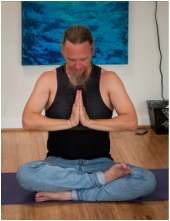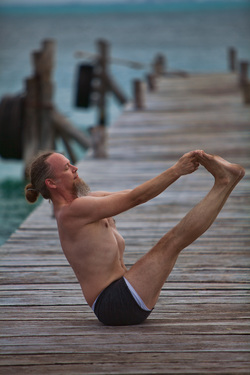I'm committing to staying on top of what foolery I believe needs to be held to account, so I will say, the two great concerns that I outlined before -- the indelible stain on the true study of Tantra, and the hyper sexualization of yoga through the actions of some male teachers and the detriment to yoga, to other male teachers, to our philosophy and to our business -- remain and unfortnately, have been exacerbated by Broad's piece of 'urinalism' - no sources cited, no fact checking on his 'history', a clear agenda and more fire for the flames to light the path to buying his book. I hesitate to give him the time.
But, he pissed me off - and that's real and I'm human and it's an experience. Of course, because I'm a yogi, and I like to practice what I teach, I have to look for clarity and discernment. I can do that in my practice; I can take my muddled mind and alleviate it's 'spinnings' by linking breath and movement. In that process, I seek focus and build that as my discipline. In that focus, I may find clarity and from that, discernment.
We know the practice is powerful, and useful. We each understand the teachings in different ways, but let us agree that the intention of asana practice is not to work so much on the physical form (although that is indeed a beneficial by-product), but rather to work on our experience in the world with the world, in ourselves and with ourselves.
For many, the asana practice is the place that can provide some of that focus, and lead to clarity. So, as we each take our place on the 'sacred colored rectangles', we must observe ourselves, lovingly, but honestly. I like to ask the question...
"Where do you go?" When it gets tough, are you present, engaged and receptive? Do you link to the breath and use that as your guide to detect what is presenting? Do you honor and observe the sensations, the emotional responses, the triggers - your samskaras? Or, do you go elsewhere into the distractions away from the action? Anything but here, or why am I here, or where else could I be?
You arrange, negotiate, carve time, make opportunity and get all ready to show up; well, show up! When you come to class, how often are you in the ‘elsewhere’ and ‘elsewhen’? When the poses present, when your least favorite asana is crowned host of the class, where do you go? When the Teacher just doesn't get the message and craft for you exactly what you'd like and deem appropriate? Where do you go?
Do you go outward, into your day, into your calendar, your checklists, your clocks? Do you go to a place of bitterness – stupid pose, idiot teacher, asshole, or sadist? Do you go to a place of defiance and tenacity - “I can beat this” or “I’m not going to be the first to go down” – are you prideful, not to be broken, can’t let teacher or student see you falter? Why, for what, in service of what? It is a practice, not a performance – do it for the work, not the praise.
When the practice overwhelms us, it’s easy to go outward and away – to reflection of how great it used to be; to projection of how it should be, could be, might be... who are we to say, living life in the mistily-remembered past or the sweetly-conceived future? Easy to hit reflection of what was, or projection of how it should be, rather than inspection of what is, and introspection on where the experience takes us.
If we return to the practice only to continue to build tension or bitterness (rather than watching the natural emanation of it), and thereby ignoring when that is coloring our perception, then we fail in our efforts for clarity. This practice is tough enough; it doesn’t need to be harder, or fought. We need to surrender to it, and recognize that sometimes the class that ‘pisses us off’ the most, is the class that really serves us if we can disassociate from the ‘pissiness’ and recognize what it tells us… what it honestly tells us, and how we chose to honor that honesty.
Big work, good work – give thanks and praise you have the skills and tools in front of you. For me, I’ll have to take Wm. J and JF back to the mat and look for some clarity – after all, it’s my yoga to love them, to love yoga, and to care for each, equally.



